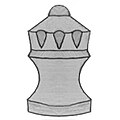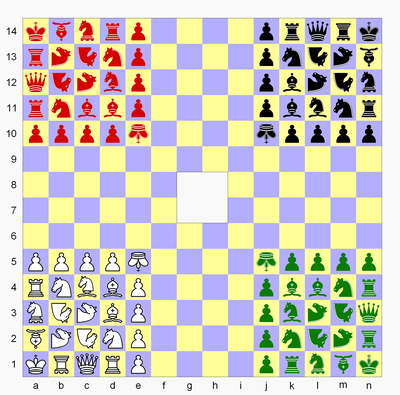
The mann (plural mannen) or man is a fairy chess piece that may move to any adjoining square. It is similar to the king, but it is not a royal piece (i.e. it is not subject to check and checkmate), and it cannot castle. The mann is used in many chess variants. In this article the mann is represented by an inverted king.
Movement
| a | b | c | d | e | f | g | h | ||
| 8 |  | 8 | |||||||
| 7 | 7 | ||||||||
| 6 | 6 | ||||||||
| 5 | 5 | ||||||||
| 4 | 4 | ||||||||
| 3 | 3 | ||||||||
| 2 | 2 | ||||||||
| 1 | 1 | ||||||||
| a | b | c | d | e | f | g | h | ||
The mann has the basic move of a king in chess: it may move to any adjoining square. It is otherwise treated as a normal chess piece (i.e. it can be captured and is not subject to check or checkmate). The mann is unable to castle. It can be thought of as the combination of a ferz and a wazir.
Value
Further information: Chess piece relative valueIn general, the mann is approximately equal in strength and value to the knight. The mann often takes a few moves to get properly developed in the opening. It is effective at close proximity, where its striking power is considerable. Although it is rather slow, the mann is excellent at both attacking and defending nearby pieces and pawns, similar to the king. The mann reaches its peak strength during the endgame, in which its value is slightly more than a knight, despite being slightly less than a knight in the opening. It is possible to force checkmate with a mann and a king against a lone enemy king; since the enemy king cannot move to attack either, it is quite easy to box the king into a corner.
History
 The Sage as how it may have appeared in Courier chess
The Sage as how it may have appeared in Courier chess Illustration of the chess piece "Mann" by Gustav Selenus from the book Das Schach-Oder Konig-Spiel (1616)
Illustration of the chess piece "Mann" by Gustav Selenus from the book Das Schach-Oder Konig-Spiel (1616)
The mann is one of the most simply described chess pieces and as such has a long history and has gone by many names. A similar piece known as the dabbaba was described c. 950 in a form of chess on a 10×10 board. The mann is used in Courier chess, invented in the 12th century and commonly played until the 18th century. Many chess variants have used the mann; modern instances include Quatrochess (as mann), Roman chess (as archer or chariot), and Knightmate (as commoner).
Examples
Each mann is represented by an inverted king in the following examples.
| a | b | c | d | e | f | g | h | ||
| 8 |  | 8 | |||||||
| 7 | 7 | ||||||||
| 6 | 6 | ||||||||
| 5 | 5 | ||||||||
| 4 | 4 | ||||||||
| 3 | 3 | ||||||||
| 2 | 2 | ||||||||
| 1 | 1 | ||||||||
| a | b | c | d | e | f | g | h | ||
| a | b | c | d | e | f | g | h | i | j | |||
| 10 | 10 | |||||||||||
| 9 | 9 | |||||||||||
| 8 | 8 | |||||||||||
| 7 | 7 | |||||||||||
| 6 | 6 | |||||||||||
| 5 | 5 | |||||||||||
| 4 | 4 | |||||||||||
| 3 | 3 | |||||||||||
| 2 | 2 | |||||||||||
| 1 | 1 | |||||||||||
| a | b | c | d | e | f | g | h | i | j |

Notes
- Names including: Man (in Courier chess), der Mann (im Kurierschach), Rath, Counsellor, Sage.
References
- "chessvariants.com -- Comment Listing". www.chessvariants.com. Retrieved 2023-04-08.
- ^ Hooper & Whyld (1996), p. 244. Mann.
- (Ward 1996:13)
- Betza, Ralph. "The WF (or Commoner)". The Chess Variant Pages.
- ^ "Courier chess". The Saint Thomas guild. June 21, 2014.
Bibliography
- Dickins, Anthony (1971) . A Guide to Fairy Chess. New York: Dover Publications Inc. ISBN 0-486-22687-5.
- Hooper, David; Whyld, Kenneth (1996) . The Oxford Companion to Chess (2nd ed.). Oxford University Press. ISBN 0-19-280049-3.
- Ward, Chris (1996). Endgame Play. Batsford. ISBN 0-7134-7920-5.
External links
- Roman Chess brief overview
- Knightmate brief overview
| Chess pieces | |
|---|---|
| Orthodox pieces | |
| Fairy pieces (List) | |
| Related | |